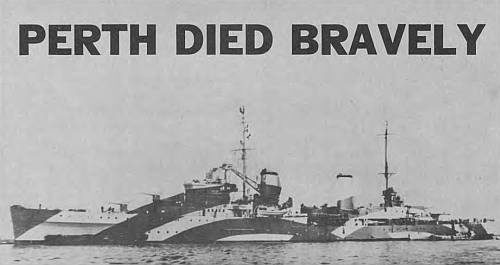- Author
- Makin, Hon. Norman J O
- Subjects
- WWII operations
- Tags
-
- RAN Ships
- HMAS Perth I
- Publication
- June 1974 edition of the Naval Historical Review (all rights reserved)

[Statement by the Minister for the Navy (the Hon. Norman J.O.Makin, M.P.) in the Australian House of Representatives, 2nd March 1945]
THIS RECONSTRUCTION of the Java Sea Battle, and of the subsequent engagement in Sunda Strait in which HMAS Perth was lost, is based on reports compiled by the Australian Commonwealth Naval Board from a variety of sources. The heavy Allied losses in the Java Sea Battle, and the fact that the only Australian ship taking part was sunk a day later, has made the task of compiling the reports long and complicated.
Fortunately, new light has been thrown on the subject by four of the personnel of HMAS Perth who were rescued from a Japanese transport which was torpedoed while en route from Singapore to Japan late last year.
These four are the only personnel of Perth in Allied hands. Their story, coupled with information pieced together from other sources, indicates that the Australian cruiser fought her two last actions with a courage and tenacity worthy of her gallant war career and of the high tradition of the Navy.
Of the Allied force which took part in the Java Sea Battle, the only ships which survived were four American destroyers. It has now been established that Perth herself sustained neither damage nor casualties in that action; but with the United States cruiser Houston she was sunk in the early hours of 1st March 1942 in Sunda Strait.
The Allied ships in the Java Sea Battle totalled two 8-inch gun cruisers (HMS Exeter and USS Houston), one 6-inch cruiser (HMAS Perth), two 5.9-inch Dutch cruisers (HNMS De Ruyter and Java), and nine destroyers (HM Ships Electra, Encounter and Jupiter; US ships John D. Edwards, John D. Ford, Alden and Paul Jones; and HNM Ships Kortenaer and Witte de With).
It has been estimated that the initial Japanese force comprised five cruisers and 13 destroyers. One enemy 8-inch cruiser and one destroyer probably were sunk by gunfire and another 8-inch cruiser and a destroyer were damaged.
On the evening of 26th February, the Allied ships sailed from Sourabaya, under command of Admiral Doorman, RNN, flying his flag in HNMS De Ruyter. Their objective was to intercept a Japanese convoy reported to be approaching north-eastern Java.
One of USS Houston’s gun turrets had already been put out of action by enemy air attack, but she sailed with the remainder of the force, and acquitted herself with distinction in the subsequent engagements with the enemy.
Enemy air attacks on the following morning were unsuccessful, and in the afternoon the Japanese cruisers and destroyers were sighted. The Allied force at once increased speed to engage the enemy, and the 8-inch cruisers of both sides opened fire at 30,000 yards. The light cruisers and destroyers followed suit as soon as range permitted.
Perth’s second salvo hit a Japanese destroyer, and the enemy flotilla retired into a smoke screen. When the smoke cleared, one enemy destroyer was on fire, and she is thought to have sunk. At that stage, too, Perth came under very heavy fire from the rearmost of the Japanese heavy cruisers.
About an hour later, HMS Exeter was damaged by an 8-inch shell, but was furnished with a smoke screen by Perth and destroyers. The Dutch destroyer Witte de With, screening Exeter, beat off a Japanese destroyer, scoring hits with two salvoes.
In the meantime HNMS Kortenaer, torpedoed amidships, broke in two and sank within a few minutes.
The flagship then led the cruisers in an attempt to get behind the enemy and attack his transports, and the Allied destroyers launched a counter-attack.
In bad visibility, HMS Electra probably scored hits with four salvoes on an enemy destroyer; but Electra herself was hit and stopped. Her guns were silenced one by one, and she sank about 6 p.m.
HMAS Perth, emerging through the smoke, was unsuccessfully attacked with torpedoes by enemy destroyers, and then joined issue with a Japanese 8-inch cruiser. The Australian ship’s opening salvoes scored direct hits and subsequent salvoes also found their mark. When her target was last seen she was on fire and stationary, with her bows in the air. She probably sank.




